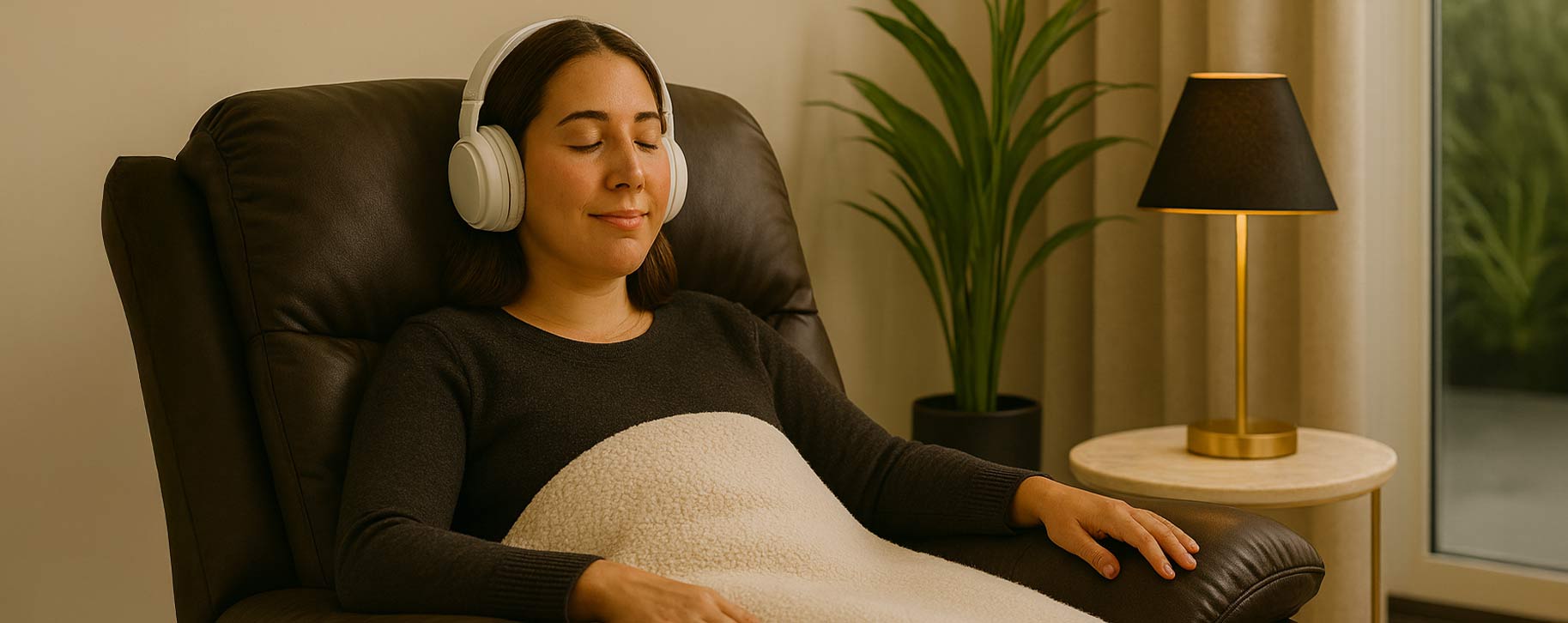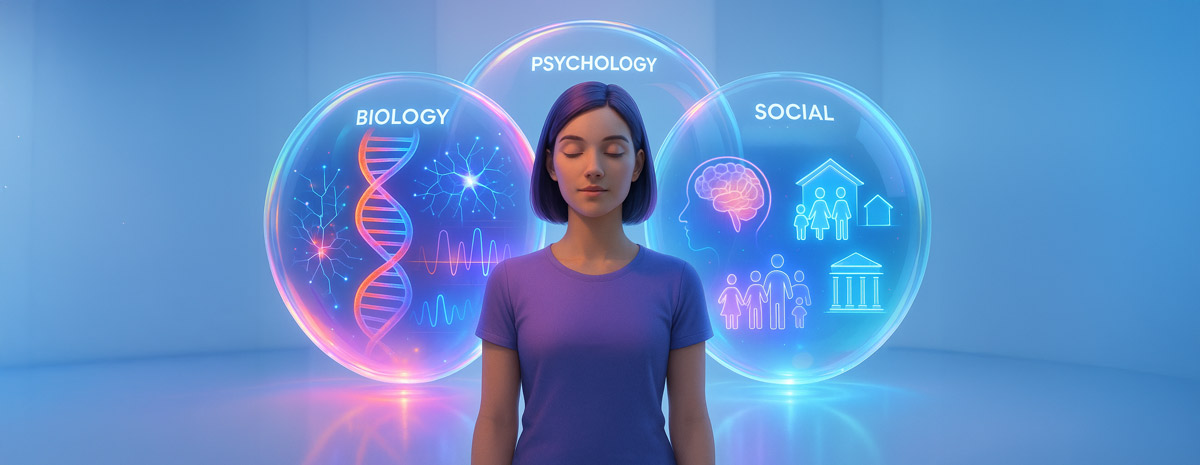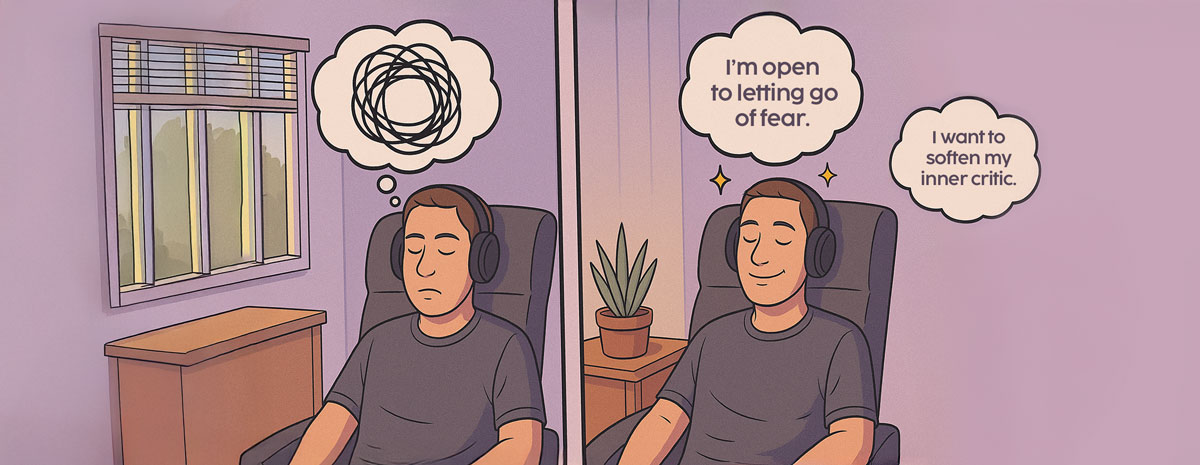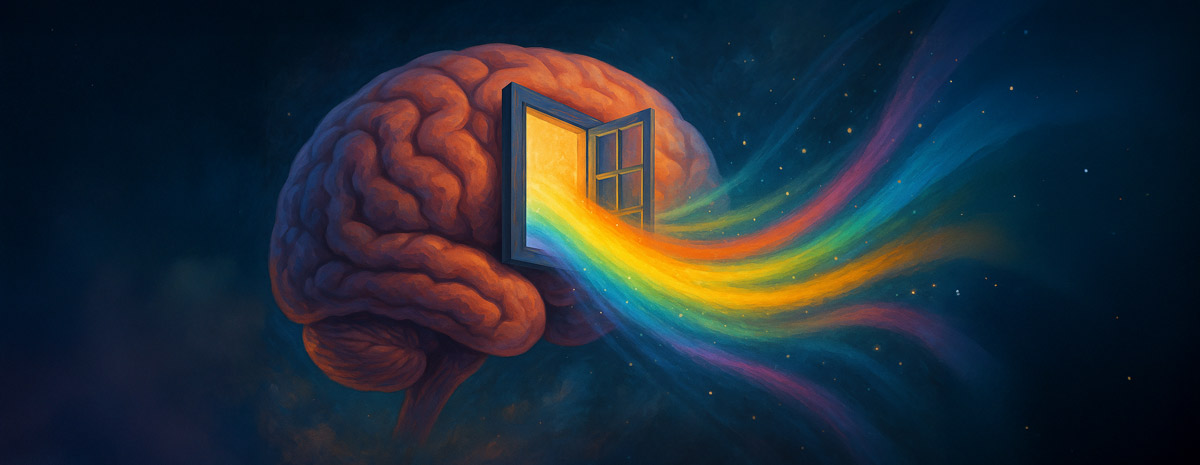Guided Imagery in Ketamine Therapy: How Mental Rehearsal Shapes Patient Response
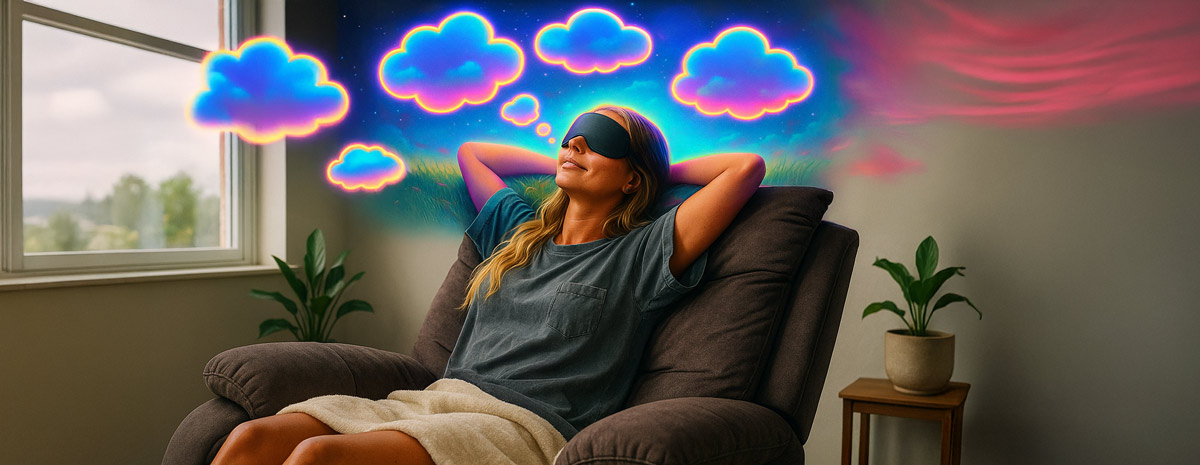
Visualization Is a Clinical Tool, Not a Wellness Trend
Guided imagery often gets lumped in with wellness trends, but neuroscience tells a very different story. At its core, guided imagery is a method of engaging the brain’s sensory and cognitive systems through deliberate mental simulation. It activates key circuits involved in movement, emotion, memory, and reflection. When used alongside ketamine therapy, it can help patients prepare for, navigate, and reflect on their experiences in meaningful ways.
The reason visualization is so impactful is simple: the brain doesn’t fully distinguish between imagined experiences and real ones. Mental rehearsal activates many of the same neural networks as lived events. This means patients can begin engaging emotional and cognitive patterns in-session, through the mind, and potentiate the effects of ketamine.
In this post, we explore the neuroscience behind guided visualization, how it enhances metacognitive awareness and emotional regulation, and why it’s a scalable resource for clinics who want to offer guided imagery ketamine therapy.
What Mirror Neurons Reveal About Mental Rehearsal
Mirror neurons are brain cells that fire both when an individual performs an action and when they observe someone else performing the same action. These neurons form the basis of empathy, imitation, and motor learning.
They were first discovered in the early 1990s by a team led by Giacomo Rizzolatti at the University of Parma, who observed this phenomenon in macaque monkeys’ premotor cortex (area F5).
Mental Rehearsal Through Visualization
When patients engage in guided visualization, imagining themselves letting go of fear, relaxing into stillness, or moving through discomfort, the mirror neuron system responds as though they are performing the action. This transforms visualization into mental rehearsal.
The brain isn’t just imagining calm, it’s practicing it. This primes the nervous system to approach discomfort with curiosity, not avoidance.
As a result, patients may experience:
- Greater emotional range
- Lower stress reactivity
- Increased familiarity with adaptive responses
Scientific Evidence for Guided Imagery
There are several studies that support the use of guided imagery as an element of medical care. The field is growing and more studies are being conducted regularly. Here are some excerpts that we found particularly interesting:
The effect of Guided imagery on perioperative anxiety
"...the included studies reported a statistically significant reduction in perioperative anxiety following guided imagery interventions. The variations in intervention protocols, such as the content, duration, and frequency of guided imagery, were observed across the studies. Patient satisfaction and acceptance of guided imagery interventions were generally high."
This study compared guided imagery (GI) to a mental‐task control on cognitive and emotional outcomes.
GI vs. Meditation: GI actively engages the imagination with vivid sensory scenes, whereas meditation emphasizes present‐moment awareness and detachment from thoughts.
Stress Reduction & Relaxation: GI produced greater stress reduction and relaxation increases than the mental‐task group.
Alpha‐Wave Enhancement: Participants in the GI group showed significantly higher EEG alpha power, a marker linked to relaxed alertness and improved attentional readiness.
Attentional Control Gains:
- Stroop task (inhibition): GI led to fewer errors, indicating better suppression of irrelevant information.
- Anti‐saccade task (shifting): GI reduced error rates, reflecting enhanced ability to switch attention.
- Go/No‐go task (vigilance): No significant GI effect, suggesting GI more strongly influences inhibition/shifting than sustained vigilance.
Alpha Power–Performance Correlation: Higher alpha power at the 14-minute mark mediated the relationship between GI and improved Stroop and anti-saccade performance.
Cognitive Flexibility: GI’s emphasis on positive visualization may particularly boost flexibility, helping shift and inhibit attention more than focused sustained attention.
Mechanistic Insight: A generalized linear model distinguished GI vs. mental‐task brain states with ~80% accuracy at minute 14, underscoring a reliable neurophysiological signature of GI.
Clinical Implications: GI offers a structured, customizable complement to mindfulness practices, with robust evidence for stress management and attentional enhancement in high-demand or anxiety-provoking contexts.
How Sensory Engagement Affects Emotional Readiness
Guided visualization is multi-sensory. It’s not just “thinking in pictures.” It can include sounds, smells, tactile cues, internal monologue, and emotions. This sensory input connects to the limbic system and autonomic regulation.
In a clinical setting, visualization may help:
- Downshift sympathetic arousal
- Increase parasympathetic tone
- Encourage emotional openness
- Improve cognitive adaptability
In a randomized controlled trial using Guided Imagery and Music (GIM), participants experienced significant reductions in cortisol levels and improvements in mood disturbance following six sessions, highlighting guided imagery’s potential for physiological stress regulation.
These effects are especially relevant in ketamine therapy, where altered states, such as dissociation or hyperarousal, are common. A well-structured visualization can offer a soft cue back toward internal stability and coherence.
To explore how visualization intersects with psychological skill-building in non-ordinary states of consciousness, read our guide to metacognition in ketamine therapy.
Visualization as a Gateway to Metacognition
Metacognition, the ability to observe one’s own thoughts and emotional patterns, is a cornerstone of long-term therapeutic growth. While it may come more naturally to some, for many, it’s a skill that must be intentionally cultivated. Guided visualization offers a gentle, effective on-ramp for developing this self-awareness.
Rather than asking patients to “analyze” or “unpack” their experiences cognitively, guided imagery helps them access internal insight through metaphor and felt sense.
A well-timed cue such as:
“Visualize your thoughts drifting past like clouds.”
…or…
“Imagine a light glowing in your chest, steady, warm, and calm.”
…invites patients to shift from identification with their thoughts to observation of them. This shift is the foundation of metacognitive awareness.
By incorporating metaphors rooted in nature, breath, and energy, such as grounding into the earth or releasing tension into light, patients begin to internalize a new kind of mental posture: one of witness, not judgment.
This experience helps them:
- Develop cognitive flexibility
- Identify reactive patterns more quickly
- Reconnect with internal resources between sessions
It also builds narrative coherence. When patients emerge from a session recalling “the river,” “the light,” or “the forest path,” they’re not just referencing scenery, they’re anchoring meaning to symbolic inner experiences. That kind of symbolic recall is one of the first steps in translating dissociative insight into real-world action.
A 2025 randomized controlled trial published in BMC Nursing found that integrating reflective visualization with narrative‑style mindfulness prompts significantly boosted emotional regulation and self‑awareness in nursing students, mirroring the therapeutic benefits seen when imagery and story‑based anchoring are combined.
Guided imagery, then, becomes more than relaxation, it becomes a bridge from felt sense to insight. And for patients navigating health challenges, that bridge may be the most vital structure of all.
Clinical Snapshot: Visualization in Practice
A ketamine clinic in California began using Limitless App guided imagery tools during sessions. These Journey Macrodoses “Intros” audio tracks encouraged patients to mentally create safe internal spaces before dosing and listening to the Macrodose that follows the intro (auto-play) during ketamine administration improved patient clarity and connection to their ketamine treatment protocol.
Within two months:
- Intake anxiety scores showed a downward trend
- Integration between sessions became more focused and structured
- Patients used consistent language to describe internal experiences
One clinical director shared:
“When patients can describe their experience metaphorically, through visuals or story, they’re able to connect more quickly to what it meant for them.”
This approach reduced the cognitive effort often needed in post-session discussions and gave patients more structure to build upon.
Explore Next Steps
Schedule a Discovery Call
See how Limitless can fit into your clinic’s workflow — helping patients engage more deeply in treatment, regulate their nervous systems, and sustain progress between sessions.
How to Use Journey Macrodoses Guided Imagery in Ketamine Therapy
Journey Macrodoses are immersive, long-form guided visualizations created to support the emotional, somatic, and cognitive dimensions of ketamine therapy. These sessions are designed for use before, during, or after treatment to help patients regulate their nervous system and process internal experiences more effectively.
1. Choose the Right Moment in the Care Arc
Use Journey Macrodoses at key points in the treatment timeline:
- Pre-session (to ease anticipatory anxiety or set an intention)
- During ketamine sessions (to anchor attention and reduce dissociation)
- Post-session or between doses (for integration and nervous system recalibration)
2. Set the Environment
Ensure the patient is in a calm, uninterrupted space with comfortable seating or lying down. Eye masks can help with light sensitivity, soft lighting and window coverings can help as well. Headphones are recommended for optimal audio immersion.
3. Select a Track Based on Intention
Ask the patient to select a track as an intention for their treatment today. If they are feeling indecissive, you can help by choosing a Journey Macrodose that aligns with one of the patient’s emotional or therapeutic goals (e.g., resilience, feeling supported, empowerment, safety, etc.). A Comfort Menu or curated playlist can help guide the selection.
To explore how intention setting further shapes this process, read our article on preparation and intention setting in ketamine therapy.
4. Press Play and Let It Run
Each Macrodose runs 60–120 minutes and is designed to play continuously. No interaction is needed. Patients simply listen and experience. The track combines:
- Breath pacing
- Somatic cues
- Music-scored guidance
- Trauma-informed scripting
FAQ: Guided Imagery in Clinical Use
Frequently asked questions about guided imagery, meditation, and guided ketamine treatments.
Yes, studies using brain imaging show that imagined movements and scenarios engage many of the same neural regions as lived experience.
No, imagery includes body sensations, emotions, somatic cues for relaxation, and symbolic representation, not just visual detail.
Yes, especially when the cues are gentle, familiar, and non-intrusive. In these moments, guided narration can serve as a soft internal anchor without placing cognitive demands on the patient. There's no expectation to follow every word. Patients can remain fully dissociated while still benefiting from the calming presence of narration and subtle metacognitive reframing.
No. Pre-recorded audio experiences, like those in Limitless ketamine therapy app help ensure safety and consistency, especially in busy practices.
Meditation promotes awareness. Guided imagery actively rehearses emotion and meaning through internal modeling.
Yes. By promoting deep relaxation and reducing session-related anxiety, guided imagery may create a calmer state of mind that may amplify the rapid antidepressant and anxiolytic effects of ketamine.
Some people prefer music only, the best ketamine therapy music is gentle, supportive, continuous, and provides safe guardrails for dissociative altered states of consciousness. The Limitless App, has a Chill Music channel made for ketamine and psychedelic therapy.
Final Thoughts
Visualization Creates Cognitive Readiness
Guided imagery invites patients to explore new internal territory, before and after ketamine therapy. It offers structured cues that promote clarity, narrative, and safety.
When patients can mentally rehearse how they want to feel, they’re more likely to engage with and remember the experience.
For related insights, read how the biopsychosocial model influences ketamine outcomes and how metacognition shapes the patient journey.
To see this in action, you can schedule a discovery call with our team and purchase a clinic license, with free training and patient onboarding materials, to give your patients an opportunity to try a Journey Macrodose during their next session.
How To Integrate Limitless App Into Your Practice
Whether you're exploring mindset support for the first time or ready to roll it out across your treatment rooms, we’ve made it simple to begin. Each kit is designed to help your team introduce Limitless with ease.
Kit
1-Month License
for Patients
for Patients

